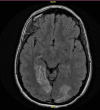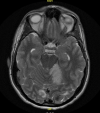Cryptogenic Stroke Caused by a Newly Diagnosed Patent Foramen Ovale in a Healthy Young Adult
- PMID: 37954786
- PMCID: PMC10636518
- DOI: 10.7759/cureus.46895
Cryptogenic Stroke Caused by a Newly Diagnosed Patent Foramen Ovale in a Healthy Young Adult
Abstract
The foramen ovale serves as an opening between the right and left atria at the site of the fossa ovalis in the fetus during uterine life. During fetal life, it makes it possible for venous blood from the maternal placenta with oxygen and nutrients to bypass the immature fetal lung and get transported to the left side of the heart and onto the systemic circulation. This hole from the right to the left atrium is usually occluded at the time of birth or shortly after birth, due to increased pressures in the left-sided cardiac cavities associated with normal breathing during delivery or shortly afterwards. If the foramen ovale remains open and fails to fuse beyond the first year of life, it is known as a patent foramen ovale (PFO). PFO occurs when, during fetal life, the septum primum and secundum, which develop and overlap normally, fail to fuse at birth. This results in the persistence of communication between the right and left atria. Paradoxical embolism from the right to the left side of the heart can occur through a PFO, causing a cryptogenic stroke or embolic stroke of an undetermined source in an otherwise healthy adult. There was a debate on the long-term benefits of closure. However, data from the randomized evaluation of the recurrent stroke comparing PFO closure to established current standard of care treatment (RESPECT) trial and two randomized trials (patent foramen ovale closure or anticoagulants versus antiplatelet therapy to prevent stroke recurrence (CLOSE) and reduction by dutasteride of prostate cancer events (REDUCE)) have clarified that there is a benefit to closure. In this case report, we describe a patient who presented with cryptogenic stroke, the investigations, imaging modalities for diagnosis of PFO, and procedure for closure. We also describe long-term outcomes and management following closure.
Keywords: amplatzer septal occluder; cryptogenic strokes; embolism and thrombosis; magnetic resonance imaging; meningioma; paradoxical embolism; patent foramen ovale (pfo); transcatheter; transcatheter repair.
Copyright © 2023, Ukponmwan et al.
Conflict of interest statement
The authors have declared that no competing interests exist.
Figures






References
-
- Patent foramen ovale and stroke. Miranda B, Fonseca AC, Ferro JM. J Neurol. 2018;265:1943–1949. - PubMed
-
- Patent foramen ovale and stroke. Homma S, Sacco RL. Circulation. 2005;112:1063–1072. - PubMed
-
- Cryptogenic stroke and patent foramen ovale. Mojadidi MK, Zaman MO, Elgendy IY, et al. J Am Coll Cardiol. 2018;71:1035–1043. - PubMed
Publication types
LinkOut - more resources
Full Text Sources
